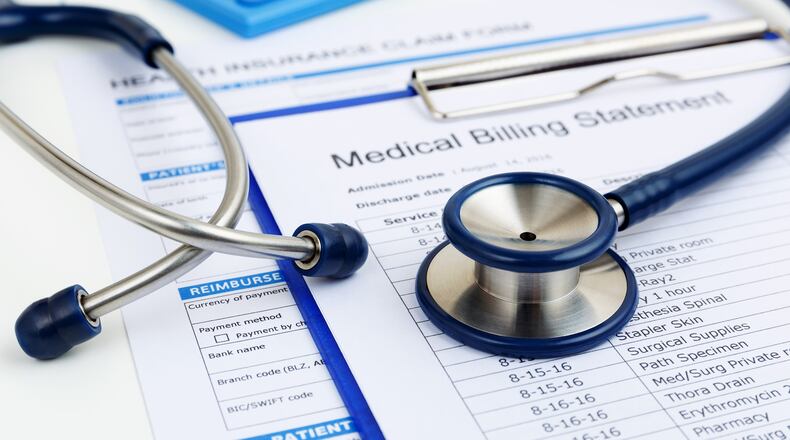The Toledo City Council just approved a plan to turn $1.6 million in public dollars into as much as $240 million in economic stimulus, targeted at some of the Ohio metro’s most vulnerable residents.
“It’s really going to help people put food on the table, help them pay their rent, help them pay their utilities,” said Toledo City Council Member Michele Grim, who led the way for the measure. “Hopefully we can prevent some evictions.”
The strategy couldn’t be simpler: It works by canceling millions in medical debt.
Working with the New York City-based nonprofit RIP Medical Debt, the City of Toledo and the surrounding Lucas County are chipping in $800,000 each out of their federal COVID-19 recovery funds from the American Rescue Plan Act.
The combined $1.6 million in funding is enough for RIP Medical Debt to acquire and cancel up to $240 million in medical debt owed by Lucas County households that earn up to 400% of the federal poverty line.
“It could be more than a one-to-100 return on investment of government dollars,” Grim says. “I really can’t think of a more simple program for economic recovery or a better way of using American Rescue Plan dollars, because it’s supposed to rescue Americans.”
Under the RIP Medical Debt model, there is no application process to cancel medical debt. The nonprofit negotiates directly with local hospitals or hospital systems one-by-one, purchasing portfolios of debt owed by eligible households and canceling the entire portfolio en masse.
“One day someone will get a letter saying your debt’s been canceled,” Grim says.
It’s a simple strategy for economic welfare and recovery.
RIP Medical Debt was founded in 2014 by a pair of former debt collection agents, and since inception it has acquired and canceled more than $7.3 billion in medical debt owed by 4.2 million households – an average of $1,737 per household.
The partnership with Toledo and Lucas County is the third instance of the public sector funding RIP Medical Debt to cancel debt portfolios.
Earlier this year, in the largest such example yet, the Cook County Board of Commissioners approved a plan to provide $12 million in ARPA funds for RIP Medical Debt to purchase and cancel an estimated $1 billion in medical debt held by hospitals across Cook County, which includes Chicago.
“Governments contract with nonprofits all the time for various social interventions,” said Allison Sesso, the CEO of RIP Medical Debt. “This isn’t really that far-fetched or different from that. I would say between five and 10 other local governments have reached out just since the Toledo story came out.”
An estimated one in five households across the U.S. have some amount of medical debt, and they are disproportionately Black and Latino, according to the U.S. Census Bureau. The average amount owed is $2,000. And the problem isn’t limited to the uninsured. As Sesso points out, many households with health insurance still end up with unpaid medical bills because the only health insurance plans affordable to them are high-deductible plans.
Acquiring medical debt is relatively cheap: hospitals that sell medical debt portfolios do so for just pennies on the dollar, usually to investors on the secondary market.
The purchase price is so low because hospitals and debt buyers alike know that medical debt is the hardest form to collect. Nearly 60% of all debt held by collection agencies is medical debt owed by some 43 million households, according to the Consumer Financial Protection Bureau.
Even more households owe medical debt that hospitals haven’t yet sold to anyone.
When it was first founded, RIP Medical Debt started out acquiring medical debt only on the secondary market, from debt collectors or other investors who had previously purchased portfolios from healthcare providers.
But two years ago, RIP Medical Debt started going directly to hospital systems and offering to buy the debt that they were holding on their balance sheets.
A year ago, Sesso says, around a quarter of the debt RIP Medical Debt had ever purchased was direct from hospitals. Today nearly 50% of the debt the nonprofit has canceled was acquired directly from hospitals, and that segment of its portfolio is growing much faster than medical debt purchased from the secondary market.
Sometimes, the hospitals themselves contact RIP Medical Debt before anyone else in their community.
The big back-end costs for RIP Medical Debt include costs to automate as much of the process as possible while also maintaining compliance with all the healthcare confidentiality laws and regulations around the secondary market for debt.
That includes paying for access to credit histories to verify that households are under the 400% of the federal poverty line threshold.
The amount of debt canceled for any given household has ranged from $25 all the way up to six-figure amounts. Under IRS regulations, debts canceled under RIP Medical Debt’s model do not count as taxable income for households.
One important limitation so far has been around using public dollars to acquire debt from public hospital systems. Rules prohibit RIP Medical Debt from using those dollars to purchase debt from county-run or city-run hospital systems.
But as it has already been doing in Chicago, the nonprofit will continue raising private funds to acquire and cancel debt portfolios from public hospitals.
After not one but two donations from philanthropist MacKenzie Scott, totaling $80 million, RIP Medical Debt is planning for expansion.
“People often ask, do you only work with nonprofit hospitals, or do you work with for-profit hospitals?” Sesso said. “And I’m like, I just want to get the debt, regardless of who created the debt. If it’s out there, I want it.”
Next City is a nonprofit news organization that believes journalists have the power to amplify solutions and spread workable ideas from one city to the next city.
About the Solutions Journalism Network
These stories come from our partners at the Solutions Journalism Network, a nonprofit organization dedicated to rigorous reporting about social issues.
About the Author
Keep Reading
The Latest
Featured


